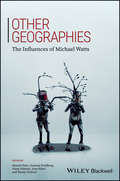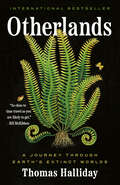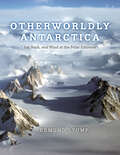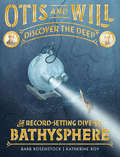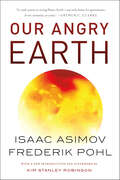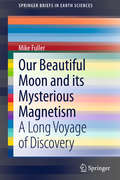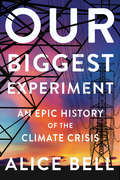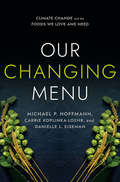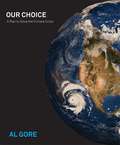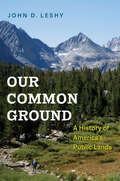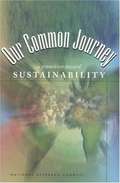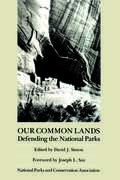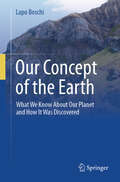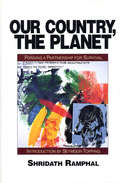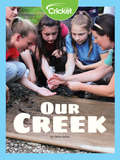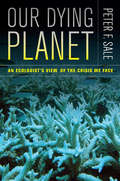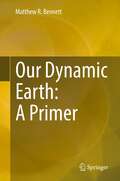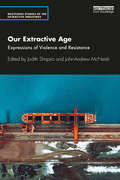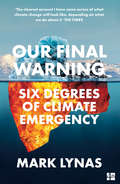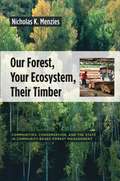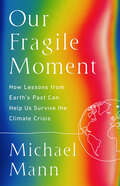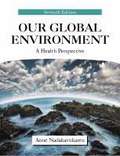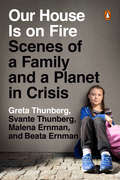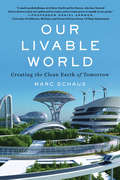- Table View
- List View
Other Geographies: The Influences of Michael Watts (Antipode Book Series)
by Wendy Wolford Susanne Freidberg Sharad Chari Vinay Gidwani Jesse RibotAn international group of distinguished scholars pay homage to and build on the work of one of the most influential thinkers of our time, Michael Watts. Shows how Michael Watts’ research, writings, teaching and mentoring have relentlessly pushed boundaries, transforming his chosen field of geography and beyond Spans an array of topics including the political economy and ecology of African societies, governmentality and territoriality in various Southern contexts, food security, cultural materialist expositions of capitalism, modernity and development across the postcolonial world Builds on his legacy, exploring its theoretical, analytical, and empirical implications and proposing exciting new possibilities for further exploration in the tracks of Watts
Otherlands: A Journey Through Earth's Extinct Worlds
by Thomas HallidayThe past is past, but it does leave clues, and Thomas Halliday has used cutting-edge science to decipher them more completely than ever before. In Otherlands, Halliday makes sixteen fossil sites burst to life on the page. <p><p> This book is an exploration of the Earth as it used to exist, the changes that have occurred during its history, and the ways that life has found to adapt―or not. It takes us from the savannahs of Pliocene Kenya to watch a python chase a group of australopithecines into an acacia tree; to a cliff overlooking the salt pans of the empty basin of what will be the Mediterranean Sea just as water from the Miocene Atlantic Ocean spills in; into the tropical forests of Eocene Antarctica; and under the shallow pools of Ediacaran Australia, where we glimpse the first microbial life. <p><p> Otherlands also offers us a vast perspective on the current state of the planet. The thought that something as vast as the Great Barrier Reef, for example, with all its vibrant diversity, might one day soon be gone sounds improbable. But the fossil record shows us that this sort of wholesale change is not only possible but has repeatedly happened throughout Earth history. Even as he operates on this broad canvas, Halliday brings us up close to the intricate relationships that defined these lost worlds. <p><p> In novelistic prose that belies the breadth of his research, he illustrates how ecosystems are formed; how species die out and are replaced; and how species migrate, adapt, and collaborate. It is a breathtaking achievement: a surprisingly emotional narrative about the persistence of life, the fragility of seemingly permanent ecosystems, and the scope of deep time, all of which have something to tell us about our current crisis.
Otherworldly Antarctica: Ice, Rock, and Wind at the Polar Extreme
by Edmund StumpWith stunning original photographs, an Antarctic scientist and explorer takes us to one of the most sublime, remote, and pristine regions on the planet. The interior of Antarctica is an utterly pristine wilderness, a desolate landscape of ice, wind, and rock; a landscape so unfamiliar as to seem of another world. This place has been known to only a handful of early explorers and the few scientists fortunate enough to have worked there. Edmund Stump is one of the lucky few. Having climbed, photographed, and studied more of the continent-spanning Transantarctic Mountains than any other person on Earth, this geologist, writer, and photographer is uniquely suited to share these alien sights. With stories of Stump’s forty years of journeys and science, Otherworldly Antarctica contains 130 original color photographs, complemented by watercolors and sketches by artist Marlene Hill Donnelly. Over three chapters—on the ice, the rock, and the wind—we meet snowy paths first followed during Antarctica’s Heroic Age, climb the central spire of the Organ Pipe Peaks, peer into the crater of the volcanic Mount Erebus, and traverse Liv Glacier on snowmobile, while avoiding fatal falls into the blue interiors of hidden crevasses. Along the way, we see the beauty of granite, marble, and ice-cored moraines, meltwater ponds, lenticular clouds, icebergs, and glaciers. Many of Stump’s breathtaking images are aerial shots taken from the planes and helicopters that brought him to the interior. More were shot from vantages gained by climbing the mountains he studied. Some were taken from the summits of peaks. Many are of places no one had set foot before—or has since. All seem both permanent and precarious, connecting this otherworld to our fragile own.
Otis and Will Discover the Deep: The Record-Setting Dive of the Bathysphere
by Katherine Roy Barb RosenstockThe suspenseful, little-known true story of two determined pioneers who made the first dive into the deep ocean.On June 6, 1930, engineer Otis Barton and explorer Will Beebe dove into the ocean inside a hollow metal ball of their own invention called the Bathysphere.They knew dozens of things might go wrong. A tiny leak could shoot pressurized water straight through the men like bullets! A single spark could cause their oxygen tanks to explode! No one had ever dived lower than a few hundred feet...and come back. But Otis and Will were determined to become the first people to see what the deep ocean looks like.This suspenseful story from acclaimed author Barb Rosenstock with mesmerizing watercolors by award-winning artist Katherine Roy will put you right in the middle of the spine-tingling, record-setting journey down, down into the deep.
Our Angry Earth
by Isaac Asimov Frederik Pohl“A lucid overview of [environmental] problems and a compelling call to action.” —Publishers WeeklyFrom two of science fiction’s most celebrated and brilliant minds—Isaac Asimov and Frederik Pohl—comes the second edition of Our Angry Earth, a comprehensive analysis of today's environmental threats and a guide on how we can heal our planet, with an introduction and afterword from New York Times bestselling author Kim Stanley Robinson.Our Angry Earth provides a candid picture of the present and many possibilities for a better, cleaner future. From the greenhouse effect and depletion of our ozone layer to nuclear waste and species extinction, Asimov and Pohl not only present accessible explanations of complex scientific processes but ways we can improve our behavior and relationship with the planet, whether it be involvement in social activism or individual lifestyle changes.Kim Stanley Robinson, author of New York Times bestsellers 2312, New York2140, and the internationally renowned Mars trilogy, brings his decades-spanning expertise in climate change to Our Angry Earth’s introduction and afterword.At the Publisher's request, this title is being sold without Digital Rights Management Software (DRM) applied.
Our Beautiful Moon and its Mysterious Magnetism
by Mike FullerThis book is a summary of the history of discovering the moon. The author has been involved in the Apollo program, working with its samples and this book covers these efforts. It describes the analysis methods of lunar samples and their interpretation to understand lunar paleomagnetism. The book has adopted an historical approach throughout, tracing the development of the ideas of the Earth-moon system, of the birth of the space age, of paleomagnetism and finally of lunar magnetism and its evidence for an early lunar dynamo.
Our Beautiful, Fragile World: The Nature and Environmental Photographs of Peter Essick
by Peter Essick"Our Beautiful, Fragile World" features a career-spanning look at the images of photojournalist Peter Essick taken while on assignment for "National Geographic" magazine. In this book, Essick showcases a diverse series of photographs from some of the most beautiful natural areas in the world and documents major contemporary environmental issues, such as climate change and nuclear waste. Each photograph is accompanied by commentary on the design process of the image, Essick's personal photographic experiences, and informative highlights from the research he completed for each story. "Our Beautiful, Fragile World" takes the reader on a journey around the globe, from the Oulanka National Park near the Arctic Circle in Finland to the Adelie penguin breeding grounds in Antarctica. "Our Beautiful, Fragile World" will interest photographers of all skill levels. It carries an important message about conservation, and the photographs provide a compelling look at our environment that will resonate with people of all ages who care about the state of the natural world. Foreword by Jean-Michel Cousteau.
Our Biggest Experiment: An Epic History of the Climate Crisis
by Alice BellTraversing science, politics, and technology, Our Biggest Experiment shines a spotlight on the little-known scientists who sounded the alarm to reveal the history behind the defining story of our age: the climate crisis.Our understanding of the Earth's fluctuating environment is an extraordinary story of human perception and scientific endeavor. It also began much earlier than we might think. In Our Biggest Experiment, Alice Bell takes us back to climate change science's earliest steps in the eighteenth and nineteenth centuries, through the point when concern started to rise in the 1950s and right up to today, where the &“debate&” is over and the world is finally starting to face up to the reality that things are going to get a lot hotter, a lot drier (in some places), and a lot wetter (in others), with catastrophic consequences for most of Earth's biomes.Our Biggest Experiment recounts how the world became addicted to fossil fuels, how we discovered that electricity could be a savior, and how renewable energy is far from a twentieth-century discovery. Bell cuts through complicated jargon and jumbles of numbers to show how we're getting to grips with what is now the defining issue of our time. The message she relays is ultimately hopeful; harnessing the ingenuity and intelligence that has driven the history of climate change research can result in a more sustainable and bearable future for humanity.
Our Changing Menu: Climate Change and the Foods We Love and Need
by Michael P. Hoffmann Carrie Koplinka-Loehr Danielle L. EisemanOur Changing Menu unpacks the increasingly complex relationships between food and climate change. Whether you're a chef, baker, distiller, restaurateur, or someone who simply enjoys a good pizza or drink, it's time to come to terms with how climate change is affecting our diverse and interwoven food system. Michael P. Hoffmann, Carrie Koplinka-Loehr, and Danielle L. Eiseman offer an eye-opening journey through a complete menu of before-dinner drinks and salads; main courses and sides; and coffee and dessert. Along the way they examine the escalating changes occurring to the flavors of spices and teas, the yields of wheat, the vitamins in rice, and the price of vanilla. Their story is rounded out with a primer on the global food system, the causes and impacts of climate change, and what we can all do. Our Changing Menu is a celebration of food and a call to action—encouraging readers to join with others from the common ground of food to help tackle the greatest challenge of our time.
Our Choice: A Plan to Solve the Climate Crisis
by Al GoreIt is now abundantly clear that we have at our fingertips all of the tools we need to solve the climate crisis. The only missing ingredient is collective will. Properly understood, the climate crisis is an unparalleled opportunity to finally and effectively address many persistent causes of suffering and misery that have long been neglected, and to transform the prospects of future generations, giving them a chance to live healthier, more prosperous lives as they continue their pursuit of happiness. Our Choice gathers in one place all of the most effective solutions that are available now and that, together, will solve this crisis. It is meant to depoliticize the issue as much as possible and inspire readers to take action - not only on an individual basis but as participants in the political processes by which every country, and the world as a whole, makes the choice that now confronts us. There is an old African proverb that says, "If you want to go quickly, go alone; if you want to go far, go together." We have to go far, quickly. We can solve the climate crisis. It will be hard, to be sure, but if we can make the choice to solve it, I have no doubt whatsoever that we can and will succeed. - Al Gore, from the introduction.
Our Common Ground: A History of America's Public Lands
by John D. LeshyThe little-known story of how the U.S. government came to hold nearly one-third of the nation&’s land and manage it primarily for recreation, education and conservation. &“A much-needed chronicle of how the American people decided––wisely and democratically––that nearly a third of the nation&’s land surface should remain in our collective ownership and be managed for our common good.&”—Dayton Duncan, author of The National Parks: America&’s Best Idea America&’s public lands include more than 600 million acres of forests, plains, mountains, wetlands, deserts, and shorelines. In this book, John Leshy, a leading expert in public lands policy, discusses the key political decisions that led to this, beginning at the very founding of the nation. He traces the emergence of a bipartisan political consensus in favor of the national government holding these vast land areas primarily for recreation, education, and conservation of biodiversity and cultural resources. That consensus remains strong and continues to shape American identity. Such a success story of the political system is a bright spot in an era of cynicism about government. This book is essential reading for anyone who cares about public lands, and it is particularly timely as the world grapples with the challenges of climate change and biodiversity loss.
Our Common Journey: A Transition Toward Sustainability
by National Research CouncilWorld human population is expected to reach upwards of 9 billion by 2050 and then level off over the next half-century. How can the transition to a stabilizing population also be a transition to sustainability? How can science and technology help to ensure that human needs are met while the planet's environment is nurtured and restored?Our Common Journey examines these momentous questions to draw strategic connections between scientific research, technological development, and societies' efforts to achieve environmentally sustainable improvements in human well being. The book argues that societies should approach sustainable development not as a destination but as an ongoing, adaptive learning process. Speaking to the next two generations, it proposes a strategy for using scientific and technical knowledge to better inform future action in the areas of fertility reduction, urban systems, agricultural production, energy and materials use, ecosystem restoration and biodiversity conservation, and suggests an approach for building a new research agenda for sustainability science.Our Common Journey documents large-scale historical currents of social and environmental change and reviews methods for "what if" analysis of possible future development pathways and their implications for sustainability. The book also identifies the greatest threats to sustainability--in areas such as human settlements, agriculture, industry, and energy--and explores the most promising opportunities for circumventing or mitigating these threats. It goes on to discuss what indicators of change, from children's birth-weights to atmosphere chemistry, will be most useful in monitoring a transition to sustainability.
Our Common Lands: Defending The National Parks
by David J. Simon Joseph L. SaxThis accessible book explains the complexities of key environmental laws and how they can be used to protect our national parks. It includes discussions of successful and unsuccessful attempts to use the laws and how the courts have interpreted them.
Our Concept of the Earth: What We Know About Our Planet and How It Was Discovered
by Lapo BoschiWith its new, unique look at the physics of the earth and at how this field got to where it is today, this is not a conventional textbook, but could easily be used as one. Designed to be understood by readers with no background in the earth sciences and only little previous knowledge of math and physics, Our Concept of the Earth differs from other geophysics books in that it places geo-scientific concepts in their historical context: ideas are presented in chronological order, according to the moment they emerged, one in response to the other, throughout the history of the discipline. In this way, the material covered in any given section of the book rests on simpler previously established concepts that are explained earlier in the book. The book is extremely self-contained and lends itself to being read from beginning to end, an experience that will captivate and even entertain a broad range of readers in academia and beyond.
Our Country, The Planet: Forging A Partnership For Survival
by Seymour Topping Shridath S. RamphalOur Country, The Planet is a wide-ranging discussion of the global environmental crisis that accounts for the positions and perceptions of both developed and developing nations. As president of the World Conservation Union and the only person to have served on all five independent international commissions on global issues, Shridath Ramphal brings to his study a unique perspective and deep understanding of both development and the environment.
Our Creek
by Celina SeftasFollow along with this class as they explore a creek near their school in Pennsylvania! They want to learn about the water and its ecosystem, so they perform a survey to determine its quality and biota. What do you think they will find?
Our Dying Planet
by Peter SaleCoral reefs are on track to become the first ecosystem actually eliminated from the planet. So says leading ecologist Peter F. Sale in this crash course on the state of the planet. Sale draws from his own extensive work on coral reefs, and from recent research by other ecologists, to explore the many ways we are changing the earth and to explain why it matters. Weaving into the narrative his own firsthand field experiences around the world, Sale brings ecology alive while giving a solid understanding of the science at work behind today's pressing environmental issues. He delves into topics including overfishing, deforestation, biodiversity loss, use of fossil fuels, population growth, and climate change while discussing the real consequences of our growing ecological footprint. Most important, this passionately written book emphasizes that a gloom-and-doom scenario is not inevitable, and as Sale explores alternative paths, he considers the ways in which science can help us realize a better future.
Our Dynamic Earth: A Primer
by Matthew R. BennettStudents taking undergraduate degrees in geography, ecology, earth science, and environmental science frequently take an introductory unit in Physical Geography. Some will have not done any geography since their early teens, while others have more recent knowledge. This range of backgrounds can be challenging for both the instructor and the student, this primer aims to help. A primer is a readable introduction to a subject, more technical than a piece of popular science, but less detailed than a specialist textbook. It aims to give the reader a platform in a subject with which they may be unfamiliar, so that they can proceed simultaneously, or sequentially, to more advanced texts and information. Ideally the primer should have something for those without any knowledge, while also challenge and entertaining those who do. Not quite bedtime reading, but a step in that direction. Our Dynamic Earth introduces students to the Earth's origins, to plate tectonics, atmospheric and oceanographic circulation, as well as to a range of Earth surface processes. Idea to get you started in your studies.
Our Extractive Age: Expressions of Violence and Resistance (Routledge Studies of the Extractive Industries and Sustainable Development)
by Judith ShapiroOur Extractive Age: Expressions of Violence and Resistance emphasizes how the spectrum of violence associated with natural resource extraction permeates contemporary collective life. Chronicling the increasing rates of brutal suppression of local environmental and labor activists in rural and urban sites of extraction, this volume also foregrounds related violence in areas we might not expect, such as infrastructural developments, protected areas for nature conservation, and even geoengineering in the name of carbon mitigation. Contributors argue that extractive violence is not an accident or side effect, but rather a core logic of the 21st Century planetary experience. Acknowledgement is made not only of the visible violence involved in the securitization of extractive enclaves, but also of the symbolic and structural violence that the governance, economics, and governmentality of extraction have produced. Extractive violence is shown not only to be a spectacular event, but an extended dynamic that can be silent, invisible, and gradual. The volume also recognizes that much of the new violence of extraction has become cloaked in the discourse of "green development," "green building," and efforts to mitigate the planetary environmental crisis through totalizing technologies. Ironically, green technologies and other contemporary efforts to tackle environmental ills often themselves depend on the continuance of social exploitation and the contaminating practices of non-renewable extraction. But as this volume shows, resistance is also as multi-scalar and heterogeneous as the violence it inspires. The book is essential reading for activists and for students and scholars of environmental politics, natural resource management, political ecology, sustainable development, and globalization.
Our Final Warning: Six Degrees of Climate Emergency
by Mark LynasWe are living in a climate emergency. But how much worse could it get? Will civilization collapse? Are we already past the point of no return? What kind of future can our children expect? Rigorously cataloguing the very latest climate science, Mark Lynas explores the course we have set for Earth over the next century and beyond. Degree by terrifying degree, he charts the likely consequences of global heating and the ensuing climate catastrophe. <P><P> At one degree – the world we are already living in – vast wildfires scorch California and Australia, while monster hurricanes devastate coastal cities. At two degrees the Arctic ice cap melts away, and coral reefs disappear from the tropics. At three, the world begins to run out of food, threatening millions with starvation. At four, large areas of the globe are too hot for human habitation, erasing entire nations and turning billions into climate refugees. At five, the planet is warmer than for 55 million years, while at six degrees a mass extinction of unparalleled proportions sweeps the planet, even raising the threat of the end of all life on Earth. <P><P> These escalating consequences can still be avoided, but time is running out. We must largely stop burning fossil fuels within a decade if we are to save the coral reefs and the Arctic. If we fail, then we risk crossing tipping points that could push global climate chaos out of humanity’s control. <P><P> This book must not be ignored. It really is our final warning.
Our Forest, Your Ecosystem, Their Timber: Communities, Conservation, and the State in Community-Based Forest Management
by Nicholas MenziesCommunity-based forest management (CBFM) is a model of forest management in which a community takes part in decision making and implementation, and monitoring of activities affecting the natural resources around them. CBFM provides a framework for a community members to secure access to the products and services that flow from the landscape in which they live and has become an essential component of any comprehensive approach to forest management. In this volume, Nicholas K. Menzies looks at communities in China, Zanzibar, Brazil, and India where, despite differences in landscape, climate, politics, and culture, common challenges and themes arise in making a transition from forest management by government agencies to CBFM. The stories of these four distinct places highlight the difficulties communities face when trying to manage their forests and negotiate partnerships with others interested in forest management, such as the commercial forest sector or conservation and environmental organizations. These issues are then considered against a growing body of research concerning what constitutes successful CBFM.Drawing on published and unpublished case studies, project reports, and his own rich experience, Menzies analyzes how CBFM fits into the broader picture of the management of natural resources, highlighting the conditions that bring about effective practices and the most just and equitable stewardship of resources. A critical companion for students, researchers, and practitioners, Our Forest, Your Ecosystem, Their Timber provides a singular resource on the emergence and evolution of CBFM.
Our Fragile Moment: How Lessons from Earth's Past Can Help Us Survive the Climate Crisis
by Michael E. MannIn this sweeping work of science and history, the renowned climate scientist and author of The New Climate War shows us the conditions on Earth that allowed humans not only to exist but thrive, and how they are imperiled if we veer off course. For the vast majority of its 4.54 billion years, Earth has proven it can manage just fine without human beings. Then came the first proto-humans, who emerged just a little more than 2 million years ago—a fleeting moment in geological time. What is it that made this benevolent moment of ours possible? Ironically, it&’s the very same thing that now threatens us—climate change. The drying of the tropics during the Pleistocene period created a niche for early hominids, who could hunt prey as forests gave way to savannahs in the African tropics. The sudden cooling episode known as the &“Younger Dryas&” 13,000 years ago, which occurred just as Earth was thawing out of the last Ice Age, spurred the development of agriculture in the fertile crescent. The &“Little Ice Age&” cooling of the 16th-19th centuries led to famines and pestilence for much of Europe, yet it was a boon for the Dutch, who were able to take advantage of stronger winds to shorten their ocean voyages. The conditions that allowed humans to live on this earth are fragile, incredibly so. Climate variability has at times created new niches that humans or their ancestors could potentially exploit, and challenges that at times have spurred innovation. But there&’s a relatively narrow envelope of climate variability within which human civilization remains viable. And our survival depends on conditions remaining within that range. In this book, renowned climate scientist Michael Mann will arm readers with the knowledge necessary to appreciate the gravity of the unfolding climate crisis, while emboldening them—and others--to act before it truly does become too late.
Our Global Environment: A Health Perspective (7th edition)
by Anne NadakavukarenA broad survey of the major environmental issues facing the world today. The dual approach describes the ecological impact of various human activities combined with specific issues of personal and community health, and emphasizes the interrelatedness of the two. Topics include depletion of the ozone layer and its consequences, global warming, current policy options for reducing carbon dioxide emissions, the disappearing Aral Sea, Everglades restoration, the deadly bacteria, and environmental racism. Annotation c. by Book News, Inc. , Portland, Or.
Our House Is on Fire: Scenes of a Family and a Planet in Crisis
by Greta Thunberg Malena Ernman Beata Ernman Svante Thunberg"A must-read ecological message of hope . . . Everyone with an interest in the future of this planet should read this book." --David Mitchell, The GuardianWhen climate activist Greta Thunberg was eleven, her parents Malena and Svante, and her little sister Beata, were facing a crisis in their own home. Greta had stopped eating and speaking, and her mother and father had reconfigured their lives to care for her. Desperate and searching for answers, her parents discovered what was at the heart of Greta&’s distress: her imperiled future on a rapidly heating planet. Steered by Greta&’s determination to understand the truth and generate change, they began to see the deep connections between their own suffering and the planet&’s. Written by a remarkable family and told through the voice of an iconoclastic mother, Our House Is on Fire is the story of how they fought their problems at home by taking global action. And it is the story of how Greta decided to go on strike from school, igniting a worldwide rebellion.
Our Livable World: Creating the Clean Earth of Tomorrow
by Marc SchausA vital guide to the frontlines of our fight against climate change and the scientific and technological innovations that will revolutionize the world. The United States&’ accelerated plans to combat the existential threat of climate change finally give reason to hope. In Our Livable World, research specialist and author Marc Schaus explores the incredible new green innovations in science and engineering that can allow us to avoid the worst repercussions of global warming as we work to usher in a sustainable, livable world. To beat a challenge the size of climate change, our solutions will have to be ambitious: solar thermal cells capable of storing energy long after the sun goes down, &“smart highways&” designed to charge your vehicle as you drive, indoor vertical farms automated to maximize crop growth with no pesticides, bioluminescent vines ready to one day replace our streetlights, jet fuel created from landfill trash—and next-generation carbon capture techniques to remove the emissions we have already released over the past several decades. Far from the geoengineering schemes of cli-fi action thrillers, real solutions are being developed, right this moment. Our Livable World features interviews with the innovators, real talk on the revolutionary technology, and a clear picture of a cleaner planet in the future. &“An important book that shows the dawn of a new kind of environmental movement―an age where we invest in deeply creative and fascinating technical solutions that work in harmony with the Earth. Marc Schaus lays out the exciting future of environmental innovation before us.&” —Katie Patrick, author of How to Save the World
